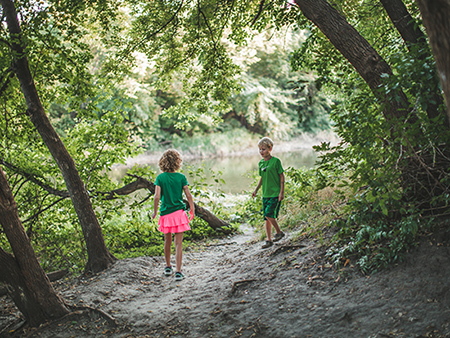 Keep your kids active this summer by enjoying the outdoors.For many kids, summer means sleeping late, pigging out and sitting in front of the TV. Adding physical activity to kids’ summer routines helps battle obesity and improves their concentration, memory and behavior, according to University of Alabama at Birmingham experts.
Keep your kids active this summer by enjoying the outdoors.For many kids, summer means sleeping late, pigging out and sitting in front of the TV. Adding physical activity to kids’ summer routines helps battle obesity and improves their concentration, memory and behavior, according to University of Alabama at Birmingham experts.
Sandra Sims, Ph.D., associate professor of kinesiology in the UAB School of Education, shares tips to help parents encourage children and adolescents to achieve the 60 minutes or more of daily physical activity recommended by the Centers for Disease Control and Prevention.
Want your kid to be active, get active yourself
Set an example for your kids by making sure you live a healthy and active lifestyle. Parents should make physical activity part of the family’s daily practices, through activities that can be done together like walking and biking. Find a new hobby or try a new sport with your child.
“Parents are great role models for their children,” Sims said. “A physically active parent is a great example and often help children follow this lead. The summer season offers great weather and longer days making an active lifestyle more accessible.”
Get out in the backyard, yours and your city’s
Explore your backyard with games or good old-fashioned unstructured play. Sims recommends trying the free, online geocaching treasure hunt game. You can check it out at www.geocaching.com.
Also, use this time of year to explore your city’s outdoor attractions. Sims suggests hiking in state parks, biking along trails and exploring the zoo.
“While you’re out, make sure your little ones consume plenty of water or low-sugar beverages for hydration,” Sims said. “And wear sunscreen and insect repellent for protection.”
Play with a goal in mind
Sims suggested planning some type of activity that works on muscular strength, using your child’s own body weight, at least three days a week.
“Younger children enjoy climbing on playground equipment or pretending to move like various animals,” she said. “Older children are capable of standard exercises such as pushups and crunches. To keep them motivated, see how many they can do in a minute, and then gradually increase the repetitions over the summer.”
The American College of Sports Medicine recommends 12,000 steps per day for children and adolescents, so Sims suggests getting pedometers for the entire family and creating a chart to post daily steps.
Just add water
Taking a dip in the pool could turn into a variety of fun and beneficial exercises. Water play becomes purposeful when you add in skills that a child knows on land.
“Many exercises that children can do on land can be done in the water,” Sims said. “You can walk or jog, do jumping jacks, slide, skip or hop. You can also play team sports like volleyball, basketball and polo.”
Get your gamer motivated
Mastering a video game is fun, but does not give you the daily physical activity your body needs. Sims encourages activities that make you stand instead of sit. Activities on a game console can be a good rainy-day alternative, but playing the actual game is more beneficial to children.
“Set some time limits for your gamer,” Sims said. “If your kids like to play interactive dance and fitness video games, adjust the setting to the level that will achieve the greatest amount of body movement. It is important to note that many sports video games are somewhat sedentary in nature, so encourage your child to find another game that is more active.”
To structure or not
Play does not always have to be structured. Unstructured play has great value, allowing children to pursue creativity in their play. Summer is a great time for unstructured play.
“Some children have been limited to playing games with rules either on a team or on a video game,” Sims said. “Allowing children freedom to choose activities and rules not only promotes creativity, but also increases enjoyment of play.”
Fun is the key word
Helping children find a physical activity that they enjoy is important. Explore new activities like dancing, football, running, hiking, baseball and softball or activities that strike your child’s interest. Summer provides an opportunity to learn more about your child’s likes and dislikes.
“Not all children are competitive, so providing only competitive sports choices is not the answer,” Sims said. “Let children explore numerous types of physical activities, so they can find one or more activities in which they can participate and enjoy doing.”
For more information, Sims recommends going to the CDC website for National Physical Activity Guidelines.